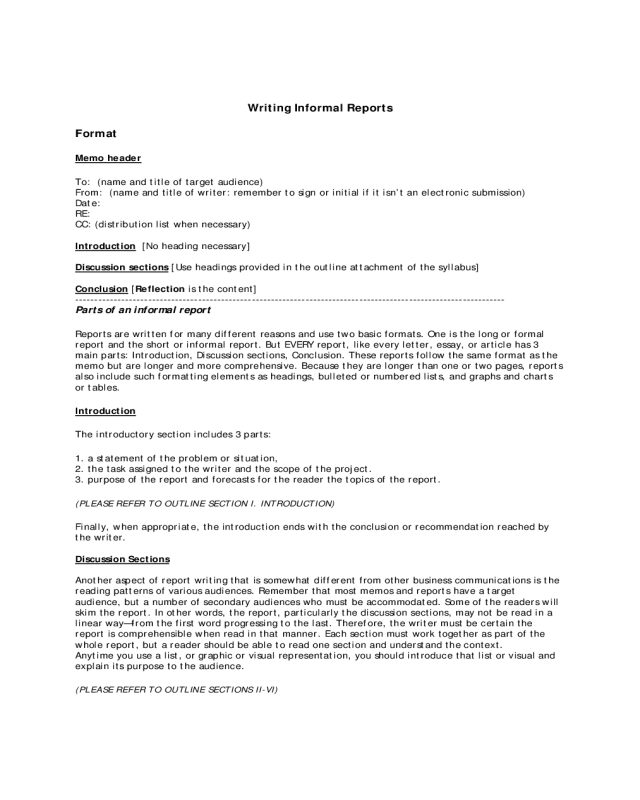Fillable Printable Informal Report Writing Format
Fillable Printable Informal Report Writing Format

Informal Report Writing Format

Writing Informal Reports
Format
Memo h e ader
To: (name and title of target audience)
From: (name and title of writer: remember to sign or initial if it isn’t an electronic submission)
Date:
RE:
CC: (distribution list when necessary)
Introduction
[No heading necessary]
Discussion sections
[Use headings pr ovided in the outline attachment of the syllabus]
Conclusion
[Reflection is the content]
----------------------------------------------------------------------------------------------------------------
Parts of an informal report
Reports are written for many different reasons and use two basic formats. One is the long or formal
report and the short or informal rep ort. But EVERY report, like every letter, essay, or article has 3
main part s: Introduction, Discussion sections, Conclusion. These reports follow the same format as the
memo but are longer and more comprehensive. Because they are longer than one or two pages, reports
also include such formatt ing elements as headings, bulleted or numbered lists, and graph s and charts
or tables.
Introduction
The introduct ory section includes 3 parts:
1. a statemen t of the problem or situation,
2. the task assigned to the writer and the scope of the project.
3. purpose of the report and forecasts for the reade r the topics of the report.
(PLEASE REFER TO OUTLINE SECTION I. INTRODUCTION)
Finally, when appropriate, the introduc tion ends with the conclusion or recommendation reached by
the writer.
Discussion Sections
Another aspe ct of report writing that is so mewhat different from other busine ss communications is the
reading patterns of various audiences. Remember that most memos and reports have a target
audience, but a number of secondary audience s who must be accommodated. Some of the reader s will
skim the report. In other words, the report, particularly the discussion sections, may not be read in a
linear way—from the f irst word progressing t o the last. Therefore, the writer must be certain the
report is comprehensible when read in that manner. Each section must work together as part of the
whole report, but a reader should be able to read one section and understand the context.
Anytime you use a list, or graphic or visual representation, you should introduce that list or visual and
explain its purpose to the audience.
(PLEASE REFER TO OUTLINE SECTIONS II-VI)

Conclusion
Finally, the conclusion of a report, depending on its purpose, should remind the reader of any action
needed, ask for a response, or indicate a willingness to answer questions. This section may also provide
contact informati on f or future communications. The Internship Experience Report conclusion should
contain a final reflection of your internship experience.
(PLEASE REFER TO OUTLINE SECTION VII. REFLECTION)
Caution: Please note that the format of business a n d professional reports includes short paragraphs of
text. So, do not use a heading as a paragraph marker. In other words, a heading may be followed by
several paragraphs.



